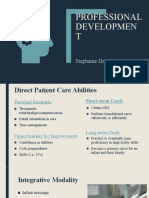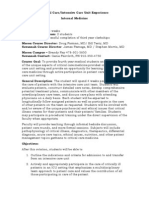Sga
Sga
Uploaded by
Lovely Princess Balaba ToraynoCopyright:
Available Formats
Sga
Sga
Uploaded by
Lovely Princess Balaba ToraynoOriginal Description:
Original Title
Copyright
Available Formats
Share this document
Did you find this document useful?
Is this content inappropriate?
Copyright:
Available Formats
Sga
Sga
Uploaded by
Lovely Princess Balaba ToraynoCopyright:
Available Formats
Nursing Management 1. Provide adequate fluid and electrolytes and nutrition.
o Provide a high calorie formula for feeding (more than 20 calories per ounce) to promote steady weight gain (15 to 30 grams per day growth plotted on curves shows a normal growth rate). o If the infant is breast feeding, add human milk fortifier to expressed breast milk. Decrease metabolic demands when possible. o Provide small frequent feedings. o Provide gavage feedings if the infant does not have a steady weight gain. o Provide a neutral thermal environment. o Decrease iatrogenic stimuli. Prevent hypoglycemia o Monitor glucose screening. o Provide early feedings. o Provide frequent feedings (every 2 to 3 hours) o Administer IV glucose if blood sugar does not normalize with oral feedings. Maintain a neutral thermal environment. Monitor serum hematocrit (normal is 45% to 65%). o If an initial high hematocrit was obtained by heel stick capillary sample, a follow-up sample should be done by venipuncture. o Observe for signs, symptoms, and complications of polycythemia Ruddy appearance Cyanosis Lethargy, jitteriness, and seizures Jaundice o Provide adequate hydration to prevent hyperviscosity Assess the prenatal history for possible toxoplasmosis, rubella, cytomegalovirus, and herpes simplex infections during pregnancy. Assess maternal and infant antibody titers. Use isolation precautions when congenital infections are suspected. Provide education and emotional support. o Explain the possible causes of intrauterine growth retardation. o Inform parents of the infants goal weight for discharge. o Provide instruction on managing the infant at home. Explain how to prepare a higher calorie formula or breast feeding. Explain the importance of follow-up with a developmental specialist who will screen for milestone achievements.
2.
3.
4. 5.
6.
7.
Nursing Diagnosis: Impaired Gas Exchange rt immature pulmonary functioning 1. assess respiratory status, noting signs of respiratory distress (e.g., tachypnea, nasal flaring, grunting, retractions, rhonchi, or crackles) Tachypnea indicates respiratory distress esp when respi are>75cpm/min after the first 5 hours of life. Expiratory grunting represents attempt to maintain alveolar expansion; nasal flaring is a compensatory mechanism to increase diameter of nares &increase Oxygen intake. 2. Assess skin color for devt of cyanosis. Lack of Oxygen will result in cyanosis 3. Promote rest, minimize stimulation& energy expenditure to decrease the metabolic rate & Oxygen consumption.
4. Give oxygen properly as indicated To improve respiratory function Nursing diagnosis: Ineffective thermoregulation r/t lack of subcutaneous fat 1. Assess V/S (esp T) Hypothermia predisposes infant to cold stress. Hyperthermia causes further respiratory depression instead of increased RR, leading to apnea &reduced O2 uptake. 2. Place infant in a warmer, isolette, Incubator, or open bed with radiant warmer or open crib wherein infant also has appropriate clothing Maintain thermoneutral environment, helps prevent cold stress 3. Use heat lamps during certain procedures & warm objects coming in contact with the infants body such as clothing Decreases heat loss to the cooler environment of the room Nursing Diagnosis: imbalanced Nutrition: less than body requirements rt small stomach capacity 1. Assess presence of reflexes associated with feeding (i.e swallowing, sucking &root) Determines the appropriate feeding method for the infant 2. Instill breast milk or formula slowly over20min @ a rate of 20ml/min Too rapid entry of feeding into stomach may cause rapid rebound response with regurgitation, increased risk of aspiration & abdomen distension all of which compromises respiratory status. 3. Initiate intermittent or tube feedings as indicted Gavage feedings may be necessary to provide adequate nutrition in infant who has a poorly coordinated suck-and-swallow reflex or who becomes fatigued during oral feedings. 4. Position infant on right side or prone with HOB elevated @30 degrees. Facilitates gastric emptying & prevents reflux. Thermoregulation The SGA baby is at greater risk of hypothermia than the appropriate for gestational age (AGA) baby.The management goal is to maintain normothermia (36.5 37.5C). by: providing a warm birth room/theatre (25 - 28C) drying the baby after birth with pre-warmed towels applying bonnet and bootees placing the stable baby in skin to skin contact (covered with a warm blanket) with his/her mother.Frequent observation (every 5 to 10 minutes) and documentation of central colour, respiratory pattern, tone and/or activity is required in the immediate postnatal period during transition to extra-uterine life.Initiation of early skin to skin contact (condition permitting) has no apparent short or long-term negative effects, is an effective method for preventing heat loss in the newborn and may be of benefit to: o Estabilish babys temperature preventing hypothermia o promote innate behaviours that assistin the initiation of breastfeeding o increase the duration of breastfeeding
o maintain normal blood glucose levels o enhance early mother baby interaction and attachment o reduce baby crying time o increase cardiorespiratory stability use of an overhead radiant warmer use of a water bed (e.g. Kanmed Baby Warmer) may be suitable for low birth weight babies who do not require intensive care or need to be observed naked in an incubator use of an incubator. Babies nursed in incuba tors should be taken out for skin to skin contact with their mothers and for breastfeeding when stable or if condition permits Hyperthermia (greater than 37.5C) is as dangerous to the newborn as hypothermia and can be prevented by not over dressing the baby and monitoring th e incubator and the babys temperature Hypoglycaemia SGA babies are at increased risk of hypoglycaemia due to: decreased muscle glycogen decreased alternative energy stores decreased gluconeogenesis decreased counter regulatory hormones increased insulin sensitivity increased insulin levels (hyperinsulinaemia) hypoxia hypothermia polycythaemia grunting Etymology: ME, grunten abnormal, short, deep, hoarse sounds in exhalation that often accompany severe chest pain. The grunt occurs because the glottis briefly stops the flow of air, halting the movement of the lungs and their surrounding or supporting structures. Grunting is most often heard in a person who has pneumonia, pulmonary edema, or fractured or bruised ribs. Atelectasis in the newborn also causes grunting, which results from the effort required to fill the lungs. Retractions, the inward movement of the skin of the chest wall or the inward movement of the breastbone (sternum) during inspiration, is an abnormal breathing pattern. Retractions mean that the child is having to use chest muscles (not usually needed) and neck muscles to get air into the lungs. The child is having to work too hard to breath. Rhonchi is the coarse rattling sound somewhat like snoring, usually caused by secretion in bronchial airways. Normal ranges: RR: 30-60 PR: 100-160 T: 36-37 Birth asphyxia occurs when a baby doesn't receive enough oxygen before, during or just after birth. There are many reasons that birth asphyxia may occur. Some of the causes of decreased oxygen before or during the birth process may include: Inadequate oxygen levels in the mother's blood due to heart or respiratory problems or lowered respirations caused by anesthesia Low blood pressure in the mother
Inadequate relaxation of the uterus during labor that prevents oxygen circulation to the placenta Early separation of the placenta from the uterus, called placental abruption Compression of the umbilical cord that decreases blood flow Poor placenta function that may occur with high blood pressure or in post-term pregnancies, particularly those past 42 weeks
Regurgitation is the expulsion of material from the mouth, pharynx, or esophagus, usually characterized by the presence of undigested food or blood Gavage (guh-vahj) feeding is a way to provide breastmilk or formula directly to your babys stomach. A tube placed through your babys nose (called a Nasogastric or NG tube) carries breast milk/formula to the stomach.
You might also like
- Behavioral Health Services With High Risk Infants and FamiliesDocument488 pagesBehavioral Health Services With High Risk Infants and Familieshosnameskar100% (1)
- Stable 2Document115 pagesStable 2Avyel KramNo ratings yet
- Baby at Risk (NBU) NotesDocument131 pagesBaby at Risk (NBU) NotesMercy Kerubo100% (1)
- Normal NewbornDocument19 pagesNormal Newbornkozume kenmaNo ratings yet
- Pyloric Stenosis: CLASS:-B.Sc. Nursing 3 YearDocument38 pagesPyloric Stenosis: CLASS:-B.Sc. Nursing 3 YearshikhaNo ratings yet
- User's Manual Incubadora SCTI Line 4Document122 pagesUser's Manual Incubadora SCTI Line 4Tuananh Nguyen100% (1)
- MCNDocument12 pagesMCNIan CarodanNo ratings yet
- Assessment Scientific Basis Plan of Care Intervention With Rationale Evaluation Subjective: IndependentDocument16 pagesAssessment Scientific Basis Plan of Care Intervention With Rationale Evaluation Subjective: IndependentAbdullah Mascardo BarabagNo ratings yet
- Davidkamau ppt2Document40 pagesDavidkamau ppt2Jimmy MainaNo ratings yet
- MCN FinalsDocument40 pagesMCN Finalsmolderoirish600No ratings yet
- High Risk NewbornDocument19 pagesHigh Risk Newbornsantosh s u100% (1)
- High Risk Newborn 1Document101 pagesHigh Risk Newborn 1f8kcznbdqjNo ratings yet
- High Risk NewbornDocument83 pagesHigh Risk NewbornChari RivoNo ratings yet
- High Risk NeonateDocument102 pagesHigh Risk NeonateJaya Prabha100% (2)
- Care of The High Risk NewbornDocument309 pagesCare of The High Risk NewbornClaire Alvarez OngchuaNo ratings yet
- Post Mature Newborn: Gervacio, Jonah Micah NDocument20 pagesPost Mature Newborn: Gervacio, Jonah Micah NJessa BorreNo ratings yet
- PretermDocument20 pagesPretermOnyishi BlessingNo ratings yet
- Newborn Lecture HandoutDocument57 pagesNewborn Lecture HandoutChesca LayosaNo ratings yet
- 10 Newborn1Document129 pages10 Newborn1Gerlian Kyle QueridoNo ratings yet
- Hyaline Membrane Disease/ Respiratory Distress SyndromeDocument28 pagesHyaline Membrane Disease/ Respiratory Distress SyndromeElvis JinjikaNo ratings yet
- Nursing Care of The High Risk Newborn and FamilyDocument31 pagesNursing Care of The High Risk Newborn and FamilyAngellie AdorioNo ratings yet
- NCM 109 Resource UnitDocument51 pagesNCM 109 Resource UnitDaryl Adrian RecaidoNo ratings yet
- Care of Iugr and Low Birth Weight BabiesDocument30 pagesCare of Iugr and Low Birth Weight BabiesjessyNo ratings yet
- Shree Siddaganga Institute of Nursing Sciences and Research CentreDocument8 pagesShree Siddaganga Institute of Nursing Sciences and Research CentreSanthosh.S.UNo ratings yet
- Neonatal Danger SignsDocument6 pagesNeonatal Danger Signsmarkus_danusantosoNo ratings yet
- High Risk NewbornDocument21 pagesHigh Risk Newbornnaga maniNo ratings yet
- Neonatal SepsisDocument8 pagesNeonatal Sepsis+nellaNo ratings yet
- Cephalopelvic DisproportionDocument7 pagesCephalopelvic DisproportionEli Ayase100% (1)
- Low Birth Weight NoteDocument9 pagesLow Birth Weight Notesushma shrestha100% (1)
- Pedia 2Document30 pagesPedia 2regNo ratings yet
- Hesi Review For MaternityDocument29 pagesHesi Review For MaternitySteam Lc86% (21)
- 39 Neonatal ResuscitationDocument38 pages39 Neonatal ResuscitationbenNo ratings yet
- My Paediatric NotesDocument14 pagesMy Paediatric NotesTicky TomNo ratings yet
- PregnancyDocument51 pagesPregnancySharmaineAnnePoliciosNo ratings yet
- Neonatal ResuscitationDocument15 pagesNeonatal ResuscitationAmruta GadeNo ratings yet
- Neonatal Resuscitation: Vineetha.T 1 Year MSC NursingDocument106 pagesNeonatal Resuscitation: Vineetha.T 1 Year MSC NursingVineetha Thachedath100% (1)
- Neonatal NCPDocument7 pagesNeonatal NCPMaria Delia SalvadoNo ratings yet
- High-Risk Newborn: Complications Associated With Gestational Age and DevelopmentDocument97 pagesHigh-Risk Newborn: Complications Associated With Gestational Age and DevelopmentALYSSA NICOLE GINESNo ratings yet
- Care of The Newborn PDFDocument5 pagesCare of The Newborn PDFzhai bambalan100% (2)
- Week 9 NCM 109 LectureDocument63 pagesWeek 9 NCM 109 LecturePolicarpio AprilNo ratings yet
- High Risk Neonates According To Gestational AgeDocument41 pagesHigh Risk Neonates According To Gestational Agesonava vichNo ratings yet
- PrematurityDocument39 pagesPrematurityElvis JinjikaNo ratings yet
- A. Cardiovascular System: Physiological Effects of Labor On A MotherDocument4 pagesA. Cardiovascular System: Physiological Effects of Labor On A MotherStudent NurseNo ratings yet
- Pyloric Stenosis: CLASS:-B.Sc. Nursing 3 YearDocument38 pagesPyloric Stenosis: CLASS:-B.Sc. Nursing 3 Yearshikha100% (2)
- Review UNIT XI High Risk NewbornDocument20 pagesReview UNIT XI High Risk NewbornShehana ShihabNo ratings yet
- New Born CareDocument17 pagesNew Born CareHarrison Tallod100% (1)
- NUR 145 Lecture 2 Term 2Document184 pagesNUR 145 Lecture 2 Term 2Maria Jonalyn Bautista RodelasNo ratings yet
- Birth AsphyxiaDocument10 pagesBirth Asphyxiasarita Singh MaharjanNo ratings yet
- Common Neonatal DisordersDocument71 pagesCommon Neonatal DisordersRANJIT GOGOI100% (3)
- EincDocument14 pagesEincmendoza jhamNo ratings yet
- Neonatal ResuscitationDocument16 pagesNeonatal ResuscitationPrecilla C. Stephen100% (3)
- Post Mature Neonate, Infant of Diabetic and Substance Abuse MotherDocument14 pagesPost Mature Neonate, Infant of Diabetic and Substance Abuse MotherShilpa JoshiNo ratings yet
- Principles of Postpartum CareDocument2 pagesPrinciples of Postpartum CareZaire DylanNo ratings yet
- NICU Nurse Core ReviewDocument8 pagesNICU Nurse Core Reviewmilkah mwauraNo ratings yet
- PretermDocument88 pagesPretermAhmed KitawNo ratings yet
- Case Study (Summer)Document30 pagesCase Study (Summer)dave del rosarioNo ratings yet
- Nursing Care During LaborDocument19 pagesNursing Care During LaborBaniwas Marie AgnesNo ratings yet
- NCPDocument7 pagesNCPmftaganasNo ratings yet
- The Effect of The Facilitated Tucking Position in Reducing Vaccination-Induced Pain in NewbornsDocument7 pagesThe Effect of The Facilitated Tucking Position in Reducing Vaccination-Induced Pain in NewbornsCassanovaNovaNo ratings yet
- Incubadoras NeonatalesDocument39 pagesIncubadoras NeonatalesMayraNo ratings yet
- Neonatal Jaundice PathwayDocument35 pagesNeonatal Jaundice Pathwaypragita ayu100% (1)
- Isbn Cohst 2022 ShareDocument82 pagesIsbn Cohst 2022 Sharecicik wijayantiNo ratings yet
- HannifansDocument11 pagesHannifansapi-583310556No ratings yet
- 1 Jyothi Sanjeevini Full DetailsDocument161 pages1 Jyothi Sanjeevini Full DetailsPramodNo ratings yet
- RN ResumeDocument1 pageRN Resumeapi-661765354No ratings yet
- EBC Ation PlanDocument16 pagesEBC Ation PlanAshu AberaNo ratings yet
- Review & Critical Appraisal of Newborn Health ProgramsDocument47 pagesReview & Critical Appraisal of Newborn Health ProgramsSagar ParajuliNo ratings yet
- 10746EN 02022 11 Depliant FM NEO WebDocument4 pages10746EN 02022 11 Depliant FM NEO WebDeasnetNo ratings yet
- 6602dcb7a0127 Opd Pamphlet Website NT 26032024 PDFDocument8 pages6602dcb7a0127 Opd Pamphlet Website NT 26032024 PDFvu3iyuNo ratings yet
- BBLRDocument9 pagesBBLREni RahmawatiNo ratings yet
- Resume FinalDocument2 pagesResume Finalapi-383975697No ratings yet
- Essential Care For Small Babies - Provider PDFDocument72 pagesEssential Care For Small Babies - Provider PDFSeeker6801No ratings yet
- Shree Siddaganga Institute of Nursing Sciences and Research CentreDocument8 pagesShree Siddaganga Institute of Nursing Sciences and Research CentreSanthosh.S.UNo ratings yet
- Critical Care/Intensive Care Unit Experience Internal Medicine INM.M INM.S CourseDocument11 pagesCritical Care/Intensive Care Unit Experience Internal Medicine INM.M INM.S CourseAmer Moh SarayrahNo ratings yet
- Basma C.VDocument2 pagesBasma C.VMahmoud SolimanNo ratings yet
- Standard Equipment ListDocument212 pagesStandard Equipment ListRuchi TapdiyaNo ratings yet
- Atom Incu-I Operation ManualDocument132 pagesAtom Incu-I Operation ManualАлександр Битунов100% (1)
- Research Paper On Premature BabiesDocument4 pagesResearch Paper On Premature Babiesc9q0c0q7100% (1)
- Newborn Massage TherapyDocument11 pagesNewborn Massage Therapydiah_budiarti_1No ratings yet
- Journal ReadingDocument13 pagesJournal Readingayu amsariNo ratings yet
- Neonatal NICU 28fgssxDocument26 pagesNeonatal NICU 28fgssxYayang AndayaniNo ratings yet
- Chapter-15 Early Stimulation: January 2014Document23 pagesChapter-15 Early Stimulation: January 2014Lina María CañónNo ratings yet
- Prototypes Design ThinkingDocument14 pagesPrototypes Design ThinkingNikita SharmaNo ratings yet
- Kangaroo Mother Care - A Research PaperDocument8 pagesKangaroo Mother Care - A Research PaperNathaniel BroylesNo ratings yet
- Obg MSC 1st YearDocument10 pagesObg MSC 1st Yearniharika mishra50% (2)
- Caffeine Therapy in Preterm InfantsDocument14 pagesCaffeine Therapy in Preterm Infantsjanfk2000No ratings yet
























































































